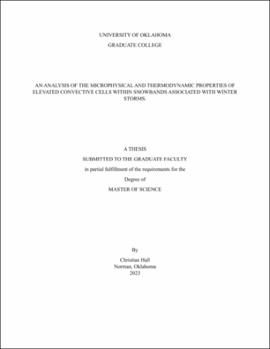| dc.description.abstract | In-situ and remote sensing observations of snowbands were obtained by probes on a cloudpenetrating NASA P-3 and a high-altitude NASA ER-2 aircraft, to identify and characterize elevated convective cells (CCs). Observations were made during the Investigation of Microphysics and Precipitation for Atlantic Coast-Threatening Snowstorms (IMPACTS) field campaign in 2020. The radar reflectivity and Doppler velocity measured by a Cloud Radar System (CRS) on the ER-2 were used to identify CCs for time periods when the horizontal separation between the ER-2 and the P-3 was less than 1.4 km, with the characteristics of smallscale air motion subsequently determined by the Turbulent Air Motion Measurement System (TAMMS) on the P-3. Through a case study analysis of collocated regions with radar confirmed CCs, an algorithm that considered the statistical significance of the range in small scale vertical velocity from the TAMMS, as well as the magnitude of the largest velocity, was developed to identify CCs using data exclusively recorded by the TAMMS. Using time periods identified as containing elevated CCs from the TAMMS for the entire 2020 IMPACTS campaign, cloud microphysical properties derived from the Rosemount Icing Detector (RICE), Fast Cloud Droplet Probe (CDP), 2D-S Stereo Probe (2DS), and High-Volume Precipitation Spectrometer (HVPS) installed on the P-3 were used to characterize the cloud microphysical properties inside and between CCs. Cloud penetrations were defined as sequences of 20-second time intervals when the P-3 encountered cloud particles at least once every 6-7 seconds, until there was a gap of at least 6-7 seconds between cloud particles. Of the 94 instances of cloud penetration identified from the P-3 analysis, 29 contained at least one CC. Contrary to previous observations of convective cells such as in generating cells in winter storms, distributions of IWC and massweighted mean particle dimension were not statistically different for data collected within and between CCs. However, mean number-weighted particle dimensions were 0.35 mm larger between CCs than within. Total number concentrations and LWC averaged 2.8 times larger and 2.3 times larger, respectively, within CCs than between. Temperatures were on average 2.4 °C greater, and dewpoint depressions 0.77 °C smaller within CCs than between. There was a 9% decrease in supercooled liquid water (SLW) presence between CCs compared to within, and SLW was detected within all TAMMS confirmed CCs. The means for defining CC regions in a substantiated way with in-situ measurements depends on the reliability of contrasting data recorded from the ER-2 and P-3 aircraft during collocated time periods, as well as the number of collocated time periods available. It is because of these limitations, and the unconventional means for detecting CCs using the TAMMS, that differences in the observed characteristics of TAMMS-confirmed CCs may be present when compared to previous studies. | en_US |
